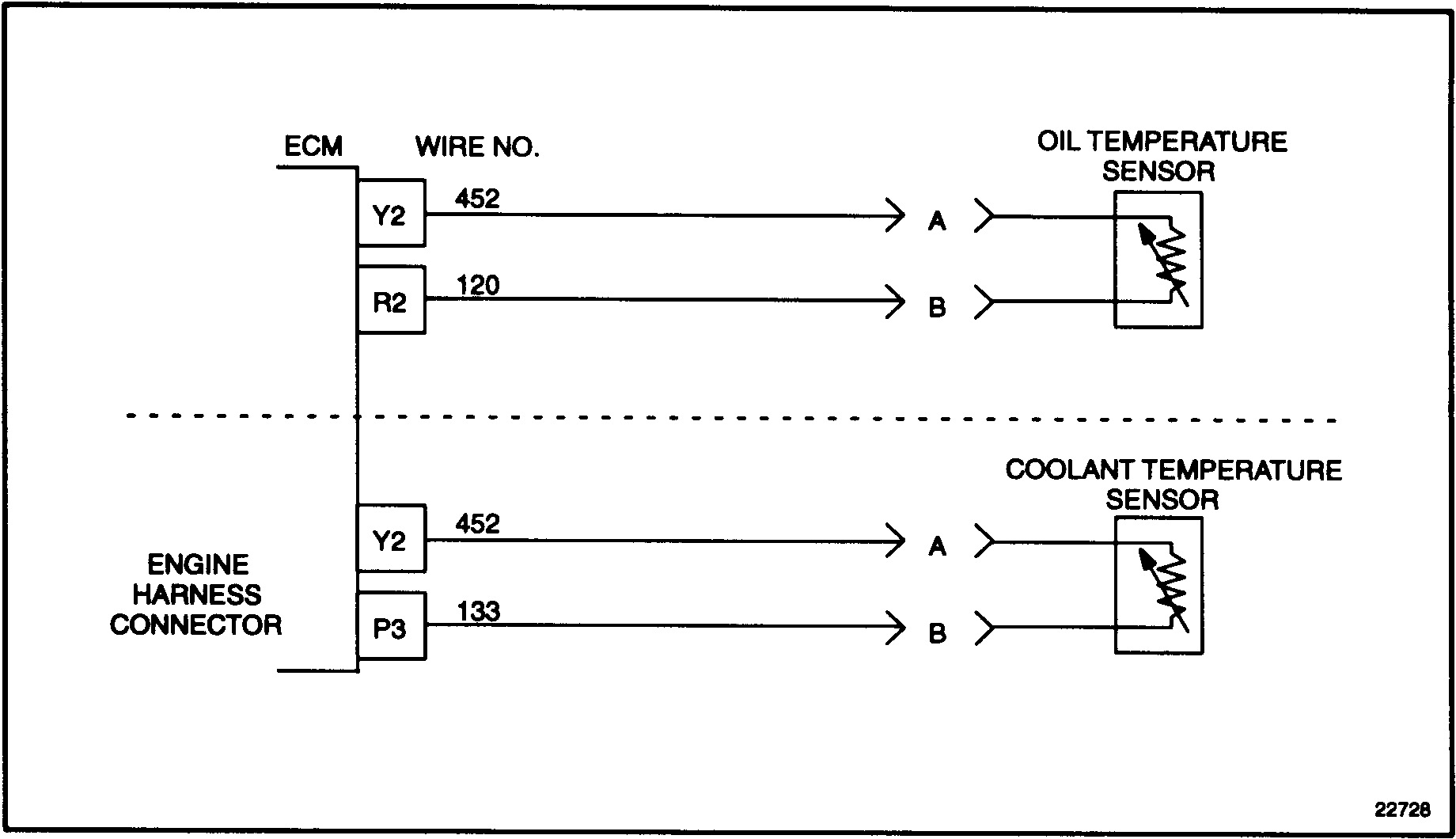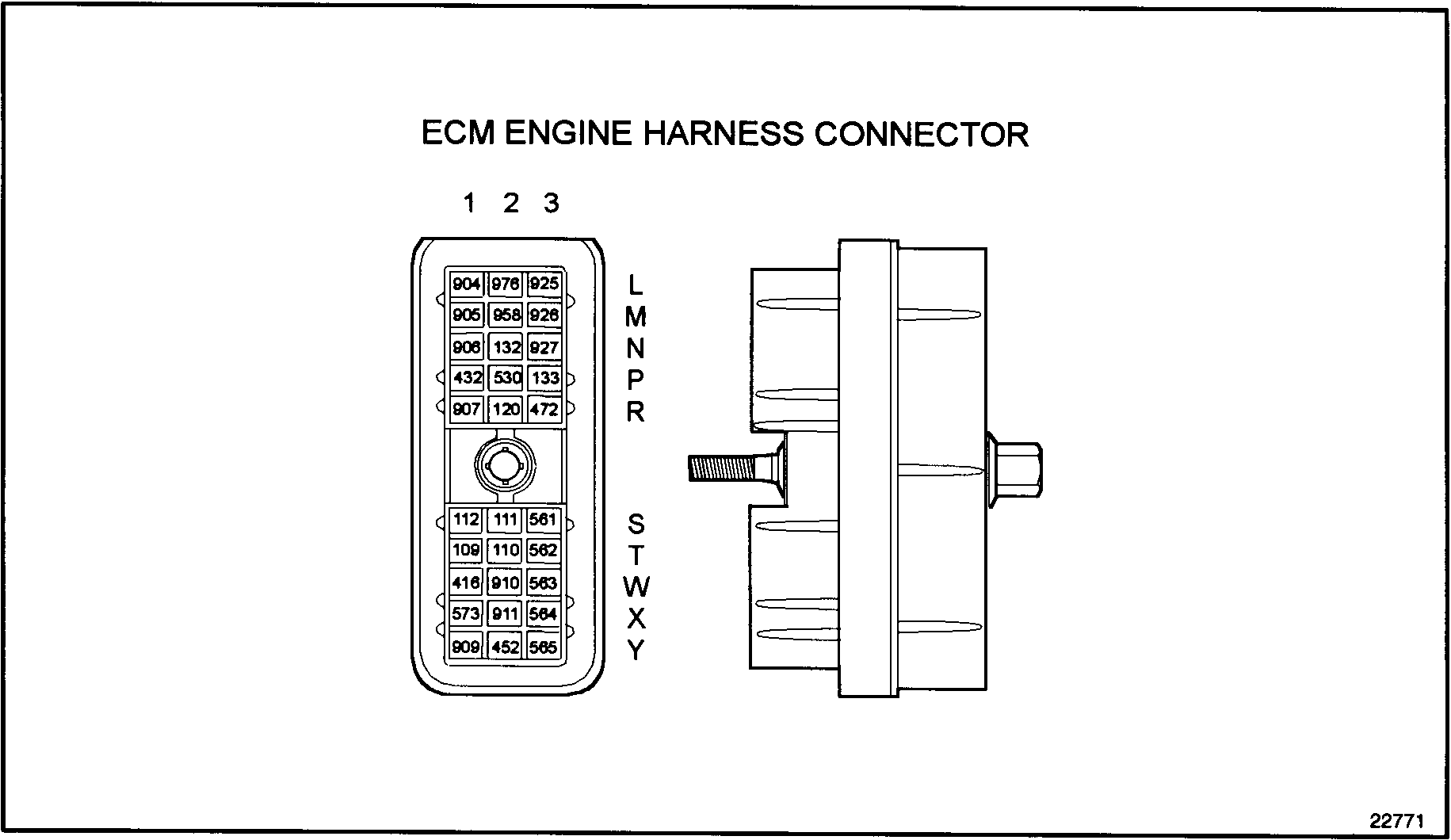Section 14.3
Troubleshooting Flash Code 14
The following procedure will troubleshoot Flash Code 14.
Section 14.3.1
Code Check
Perform the following steps to check for codes.
- Turn vehicle ignition ON.
- Plug in diagnostic data reader (DDR) and determine which code is logged.
- If codes PID 110-FMI 3 is logged, refer to "14.3.2 Coolant Temperature Sensor Check" .
- If codes PID 175-FMI 3 is logged, refer to "14.3.3 Oil Temperature Sensor Check" .
Section 14.3.2
Coolant Temperature Sensor Check
Perform the following steps to check the coolant temperature sensor (CTS).
- Turn vehicle ignition OFF.
- Disconnect CTS and install a jumper between the CTS connector sockets A and B. See Figure "Temperature Sensor Circuits" .
- Turn vehicle ignition ON.
- Read active codes.
- If code 110/4 or any other codes except 110/3 are logged, refer to "14.3.8 Open Line Check " .
- If code 110/3 is logged and any codes except code 110/4 are logged, refer to "14.3.4 Check for Signal Short to +5 Volt Line" .

Figure 1. Temperature Sensor Circuits
Section 14.3.3
Oil Temperature Sensor Check
Perform the following steps to check the oil temperature sensor (OTS).
- Turn vehicle ignition OFF.
- Disconnect OTS and install a jumper between OTS connector sockets A and B. See Figure "Temperature Sensor Circuits" .
- Turn ignition ON.
- Read active codes.
- If code 175/4 is logged, refer to "14.3.5 Check for Signal Short to +5 Volt Line" .
- If code 175/3 is logged and any codes except code 175/4 are logged, refer to "14.3.9 Open Line Check" .

Figure 2. Temperature Sensor Circuits
Section 14.3.4
Check for Signal Short to +5 Volt Line
Perform the following steps to check for a short to the +5 volt line.
- Turn ignition OFF.
- Remove jumper wire.
- Disconnect the engine harness connector at the ECM.
- Measure resistance between sockets P3 #133 and W1 #416 on the engine harness connector. See Figure
"ECM Engine Harness Connector"
.
- If the resistance measurement is greater than 5 Ω or open, refer to "14.3.6 Check Coolant Temperature Sensor Connectors" .
- If the resistance measurement is less than or equal to 5 Ω, the signal line (#133) is shorted to the engine +5 volt line (#416). Repair the short and refer to "14.3.11 Verify Repairs" .

Figure 3. ECM Engine Harness Connector
Section 14.3.5
Check for Signal Short to +5 Volt Line
Perform the following steps to check for a short to the +5 volt line.
- Turn vehicle ignition OFF.
- Remove jumper wire.
- Disconnect the engine harness connector at the ECM.
- Measure resistance between sockets R2 #120 and W1 #416 on the engine harness connector. See Figure
"ECM Engine Harness Connector"
.
- If the resistance measurement is greater than or equal to 5 Ω, refer to "14.3.7 Check Oil Temperature Sensor Connectors" .
- If the resistance measurement is less than 5 Ω, the signal line (#120) is shorted to the engine +5 volt line (#416). Repair the short and refer to "14.3.11 Verify Repairs" .
Section 14.3.6
Check Coolant Temperature Sensor Connectors
Perform the following steps to check the CTS connectors.
- Check terminals at the CTS connector (both sensor and harness side) for damage; bent, corroded and unseated pins or sockets. See Figure
"Temperature Sensor Circuits"
.
- If terminals and connectors are in good condition, replace the CTS. Refer to "14.3.11 Verify Repairs" .
- If the terminals and connectors are damaged, repair them. Refer to "14.3.11 Verify Repairs" .

Figure 4. Temperature Sensor Circuits
Section 14.3.7
Check Oil Temperature Sensor Connectors
Perform the following steps to check the OTS connectors.
- Check terminals at the OTS connector (both sensor and harness side) for damage: bent, corroded and unseated pins or sockets. See Figure
"Temperature Sensor Circuits"
.
- If terminals or connectors are damaged, repair them. Refer to "14.3.11 Verify Repairs" .
- If terminals and connectors are not damaged, replace the OTS. Refer to "14.3.11 Verify Repairs" .

Figure 5. Temperature Sensor Circuits
Section 14.3.8
Open Line Check
Perform the following steps to check for an open line.
- Turn ignition OFF.
- Disconnect the engine harness connector at the ECM. Leave the jumper wire between A and B of the Temperature Sensor Connector.
- Measure resistance between sockets P3 (#133) and Y2 (#452) on the engine harness connector. See Figure
"ECM Engine Harness Connector"
.
- If the resistance measurement is less than or equal to 5 Ω, refer to "14.3.10 Check ECM Connectors" .
- If the resistance measurement is greater than 5 Ω or open, the signal line (#133) or return line (#452) is open. Repair the open. Refer to "14.3.11 Verify Repairs" .

Figure 6. ECM Engine Harness Connector
Section 14.3.9
Open Line Check
Perform the following steps to check for an open line.
- Turn ignition OFF.
- Disconnect the engine harness connector at the ECM. Leave the jumper wire between A and B of the Temperature Sensor Connector.
- Measure resistance between sockets R2 (#120) and Y2 (#452) on the engine harness connector. See Figure
"ECM Engine Harness Connector"
.
- If the resistance measurement is less than or equal to 5 Ω, refer to "14.3.10 Check ECM Connectors" .
- If the resistance measurement is greater than 5 Ω or open, the signal line (#120) or return line (#452) is open. Repair the open. Refer to "14.3.11 Verify Repairs" .
Section 14.3.10
Check ECM Connectors
Perform the following steps to check the ECM connectors.
- Check terminals at the ECM engine harness connector (both ECM and harness side) for damage: bent, corroded and unseated pins or sockets. See Figure
"ECM Engine Harness Connector"
.
- If terminals or connectors are damaged, repair them. Refer to "14.3.11 Verify Repairs" .
- If terminals and connectors are not damaged, replace the CTS/OTS.

Figure 7. ECM Engine Harness Connector
Section 14.3.11
Verify Repairs
Perform the following steps to verify repairs.
- Turn vehicle ignition OFF.
- Reconnect all connectors.
- Turn vehicle ignition ON.
- Clear codes.
- Start and run the engine for eight minutes.
- Stop engine.
- Check DDR for codes.
- If no codes are logged, troubleshooting is complete.
- If code 110/3 or 175/3 and any other codes are logged, all system diagnostics are complete. Review this section to find the error. Refer to "14.3.1 Code Check" .
- If any codes except code 110/3 or 175/3 are logged, refer to "9.1 First Step for Diagnosing a Fault Within the DDEC System" .
| DDEC III/IV Single ECM Troubleshooting Guide - 6SE497 |
| Generated on 10-13-2008 |